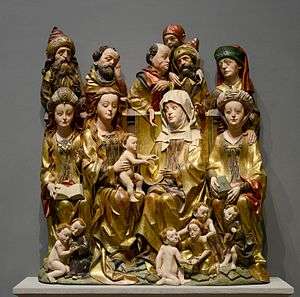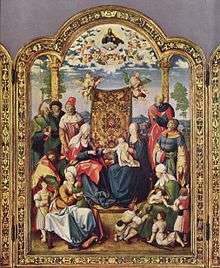Holy Kinship
 | |
| Artist | Anonymous South German (Swabian or Franconian) |
|---|---|
| Year | circa 1480-90 |
| Medium | Polychrom wood wood |
| Location | National Gallery of Art, Washington |
Holy Kinship was a popular theme in religious art throughout Germany and the Low Countries, especially during the late 15th and early 16th centuries. The Holy Kin were the extended family of Jesus descended from his maternal grandmother St. Anne. According to this tradition, St. Anne, the mother of the Virgin Mary, was grandmother not just to Jesus but also to five of the twelve apostles: John the Evangelist, James the Greater, James the Less, Simon and Jude. These apostles, together with John the Baptist, were all cousins of Jesus. The genealogy holds that Anne’s sister, Hismeria (or Esmeria), was the mother of John the Baptist’s mother Elizabeth and of a second child, Eliud, who was in turn the grandfather of St. Servatius.
The basis for this family tree rests upon the trinubium, the tradition that Anne had married three times. The exact lineage, as laid out in Jacobus de Voragine’s Golden Legend (Latin: Legenda Aurea), runs thus:
- Anna solet dici tres concepisse Marias,
- Quas genuere viri Joachim, Cleophas, Salomeque.
- Has duxere viri Joseph, Alpheus, Zebedeus.
- Prima parit Christum, Jacobum secunda minorem,
- Et Joseph justum peperit cum Simone Judam,
- Tertia majorem Jacobum volucremque Johannem.[1]
- (Anna is usually said to have conceived three Marys,
- Whom her husbands Joachim, Cleophas, and Salome begot.
- These [Marys] the men Joseph, Alpheus, and Zebedee took in marriage.
- The first bore Christ; the second bore James the Less,
- Joseph the Just, with Simon [and] Jude;
- The third, James the Greater and the winged John.)[2]
The first theologian to set forth the concept of the trinubium was Haymo of Halberstadt in his Historiae sacrae epitome, in which he outlined the family tree described above.
Gallery
 Master of the Holy Kinship, 1500
Master of the Holy Kinship, 1500 Master from Okoličné, c. 1510
Master from Okoličné, c. 1510
 Wolf Traut
Wolf Traut
| Wikimedia Commons has media related to Holy Kinship. |
References
- ↑ Jacobus de Voragine’s Golden Legend, Volume II, Chapter 131
- ↑ http://www.aug.edu/augusta/iconography/goldenLegend/maryNativity.htm